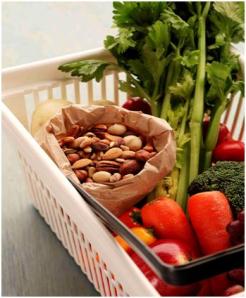
Eat nuts for polycystic ovary syndrome (PCOS)? Image source: Nuts for Life – www.nutsforlife.com.au
One in sixteen young women is afflicted with Polycystic Ovary Syndrome (PCOS). In PCOS the sex hormones get out of balance. Many women experience a decrease in ovulation and grow facial hair. Most will have small cysts grow on their ovaries. PCOS affects a woman’s hormones, vascular health, fertility, menstrual cycle, and insulin production. Women with PCOS are at an increased risk for Type 2 Diabetes Mellitus (T2DM) as a result of insulin resistance due to the extra weight around their waist. This condition affects 1 in 16 young women. The cause of PCOS is not understood, however, it does seem to run in families.
Controlling blood sugar is critical for long-term health of women with PCOS. It is helpful to follow a diet recommended by the American Diabetes Association. This would include managing energy input, increasing exercise, and emphasizing carbohydrates from fruits, vegetables, legumes and whole grains. Increase fiber to 28 grams per day and eat two or more servings of fish a day.
In addition to the above recommendations, nuts should be included in the diet. Nuts are a good source of polyunsaturated fatty acids (PUFA’s) and monounsaturated fatty acids (MUFA’s), which are beneficial to plasma lipids. Nuts are also a great source of both soluble and insoluble fiber. Fiber has a positive effect on serum glucose levels by slowing the absorption of glucose in the small intestine. Nuts also increase satiety, this being very beneficial when trying to lose weight. Walnuts have a high level of PUFA’s. PUFA’s have been shown to increase insulin secretion. In 2011, Nutrition and Metabolism published a study showing that fasting insulin was greater in those individuals who were given whole nuts. The dual effect of increased insulin secretion and slowing of glucose absorption in the small intestines resulted in a decrease of blood glucose. These positive results were also pointed out in the European Journal of Clinical Nutrition during a study in which PCOS patients consumed 31 grams a day of nuts for 6 weeks.
In conclusion, women with PCOS may benefit by consuming about ¼ cup of nuts, including walnuts every day to help decrease blood glucose. Controlling blood glucose in women at risk or who have T2DM is the first line of defense to long term medical problems.
WILTED BRUSSELS SPOUTS WITH WALNUTS
Source: Mel Melcon, Los Angeles Times, December 23, 2009
6 servings
1 Tablespoon sherry vinegar
1 teaspoon Dijon mustard
2 Tablespoons walnut oil
Salt
1 Tablespoon olive oil
1/3 cup chopped toasted walnuts
1 pound Brussels sprouts
- Prepare the Brussels sprouts: Trim the dried bases and pull away any loose or discolored outer leaves. Stand the sprout upright on the cutting board and slice it as thin as possible into coins. Aim for pieces as thin as a quarter.
- In a small-lidded jar, combine the vinegar and minced shallot, and set aside for 10 minutes. Add the mustard and walnut oil and shake well to make a smooth emulsion. Taste and season with salt as needed.
- Heat the olive oil over high heat in a large nonstick skillet. When the oil is very hot but not smoking, add the Brussels sprouts, sprinkle with on-half teaspoon salt and cook, tossing until the sprouts start to wilt, 2 to 3 minutes. The texture should be chewy crisp rather than simply crisp.
- Immediately pour over the dressing and remove from the heat. Continue tossing to evenly coat the sprouts with the dressing (they will only be very lightly coated). Stir in the walnuts and serve either warm or at room temperature.
Each serving: 153 calories; 3 grams protein; 7 grams carbohydrates; 3 grams fiber; 14 grams fat; 1 gram saturated fat; 28 mg sodium
Written by: Sherry Schulman, Student Intern for Professor Christi Coy, MS, RD, Saddleback College




